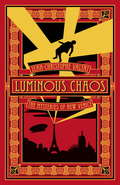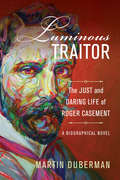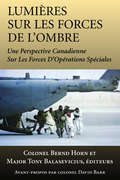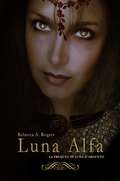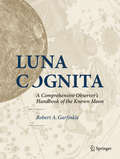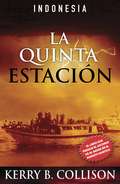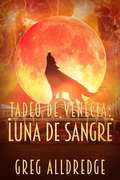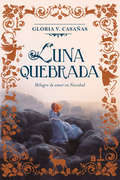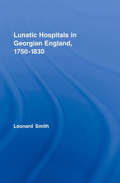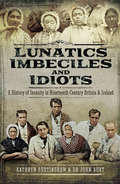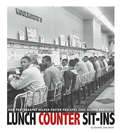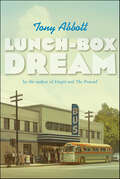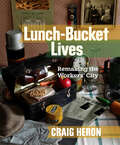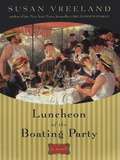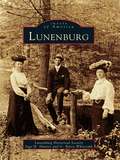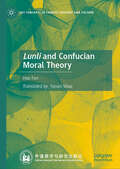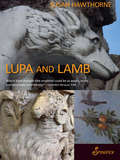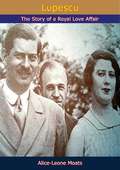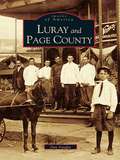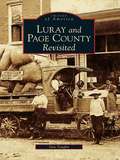- Table View
- List View
Luminous Chaos
by Jean-Christophe Valtat Mahendra SinghBook two in The Mysteries of New Venice, the steampunk adventure series The Guardian called a "magnificent achievement" It's 1907 in the icily beautiful New Venice, and the hero of the city's liberation, Brentford Orsini, has been deposed by his arch-rival -- who immediately assigns Brentford and his friends on a dangerous diplomatic mission to Paris.So, Brentford recruits his old friend and louche counterpart, Gabriel d'Allier, underground chanteuse and suffragette Lillian Lake, and the mysterious Blankbate--former Foreign Legionnaire and leader of the Scavengers, the city's garbage collecting cult--and others, for the mission.But their mode of transportation--the untested "transaerian psychomotive"--proves faulty and they find themselves transported back in time to Paris 1895 ... before New Venice even existed. What's more, it's a Paris experiencing an unprecedented and crushingly harsh winter.They soon find themselves involved with some of the city's seediest, most fascinating inhabitants. But between attending soirees at Mallarmé's house, drinking absinthe with Proust, trying to wrestle secrets out of mesmerists, and making fun of the newly-constructed Eiffel Tower, they also find that Paris is a city full of intrigue, suspicion, and danger.For example, are the anarchists they encounter who are plotting to bomb the still-under construction Sacre Coeur church also the future founders of New Venice? And why are they trying to kill them?And, as Luminous Chaos turns into another lush adventure told in glorious prose rich in historical allusion, there's the biggest question of them all: How will they ever get home?ebook ISBN: 978-1-61219-142-3
Luminous Traitor: The Just and Daring Life of Roger Casement, a Biographical Novel
by Martin DubermanRoger Casement was an internationally renowned figure at the beginning of the 20th century, famous for exposing the widespread atrocities against the indigenous people in King Leopold's Congo and his subsequent exposure—for which he was knighted in 1911—of the brutal conditions of enslaved labor in Peru. An Irish nationalist of profound conviction, he attempted, at the outbreak of World War I, to obtain German support and weapons for an armed rebellion against British rule. Apprehended and convicted of treason in a notorious trial that captured worldwide attention, Casement was sentenced to die on the gallows. A powerful petition drive for the commutation of his sentence was inaugurated by George Bernard Shaw and a host of other influential figures. A gay man, Casement kept detailed diaries of his sexual escapades, and the British government, upon discovering the diaries, circulated its pages to public figures, thereby crippling what had been a mounting petition for clemency. In 1916, he was hanged. In this gripping reimagining, acclaimed historian Martin Duberman paints a full portrait of the man for the first time. Tracing his evolution from servant of the empire to his work as a humanitarian activist and anti-imperialist, Duberman resurrects and recognizes all facets—from the professional to the personal—of the fantastic life of this pioneer for human rights.
Lumières sur les forces de l'ombre
by Colonel Bernd Horn Tony Balasevicius Colonel David BarrLes Forces d’opérations spéciales (SOF) n’ont jamais fait partie intégrante des capacités militaires du Canada. Des unités spéciales ont certes existé à certaines périodes de notre histoire, mais elles ont toujours oeuvré dans l’ombre, à la limite de la reconnaissance. Elles ont presque toujours ete marginalisées. Cependant, la tragique attaque lancée par des terroristes sur les tours jumelles du World Trade Center à New York, le 11 septembre 2001, a considérablement modifié leur image. Les SOF sont devenues depuis des forces de premier plan. Les éssais qui forment cet ouvrage concernant les SOF ont été redigés par des experts en la matière. Pris collectivement, ils constituent un recueil exhaustif d’informations et de connaissances sur les SOF canadiennes et sur des questions et sujets qui s’y rapportent. En somme, l’ouvrage permet au lecteur d’acquérir une solide base sur la théorie, le contexte historique et l’évolution des SOF, y compris les événements qui favorisent leur expansion.
Luna
by Shiv Kumar BatalviShiv Kumar Batalvi's Luna has by now won the status of a minor classic in modern Punjabi literature. It has been translated into Hindi already and staged many a time in India and abroad. The secret of its popularity lies in the abiding interest of the people in its ancient theme and Batalvi's effort to present it in the relevant modern form. Batalvi has succeeded in achieving in the text a rich texture. He has used classical references and a complex dialectical symbolism. Its lingering lyricism has retained the folk tradition of musical rendition of all legends which is so dear to all Punjabi.
Luna Alfa
by Rebecca A. Rogers Carla AltieriLa novella prequel di Luna D'Argento. Primo bacio. Primo amore. Primo. . . morso di licantropo? Cinquecento anni fa, i fratelli Ulric e Alaric lavoravano instancabilmente nella fattoria di loro padre per sfamare le loro bocche e vendere il restante raccolto per uno scarso ricavato. Con una ribellione in atto nel Nord dell'Inghilterra e un Paese in guerra per il trono, la profonda tristezza sopportata molto a lungo da Alaric e Ulric finalmente viene dissipata dallo stabilirsi di una nuova famiglia in città. I genitorni di Daciana la trappano da Londra per iniziare una nuova vita a Colchester. Qui, lei non sarà impegnata in bellissime feste ed eleganti balli; sarà messa a dura prova dal massacrante lavoro. Ma il suo obiettivo di fuggire dalla pittoresca città fallisce quando incontra Ulric. Insieme, è come se fossero esattamente dove dovrebbero essere. Durante una caccia al lupo in tarda notte, Ulric e Daciana vengono attaccati. Prima che i loro corpi possano soccombere al selvaggio animale che si cela dentro di loro, la strega del paese sostiene di avere una cura. Ma invece che guarire le loro ferite, lancia una maledizione su Ulric e Daciana, così che loro debbano vivere per ciò che sono veramente. In una città dove i segreti non rimangono tali molto a lungo e il tradimento è all'ordine del giorno, Ulric e Daciana vengono perseguitati per i mostri che sono diventati, perfino da quelli che amano.
Luna Cognita: A Comprehensive Observer’s Handbook of the Known Moon
by Robert A. GarfinkleThis comprehensive three-volume set takes you on an incomparable journey of our closest celestial neighbor. Not since the golden age of 19th-century lunar guidebooks has one author managed to cover the Moon in such detail as this all-in-one handbook. The handbook begins with a section on the Moon’s place in human history, mythology and lore, before gravitating closer to the Moon itself through scientific sections on the Earth-Moon system, lunar motions and cycles. Following these are technical chapters on how to purchase, use and care for lunar observing and photography equipment. Techniques for observing the Moon (both with the naked eye and optical instruments) are detailed as the reader approaches the Moon’s surface on this visual tour-de-force. A close-up exploration of the Moon is the result. The “crater-hop” chapters discuss the physical aspects of the Moon’s features, offering brief biographical information on the person for whom the feature is named, as well as how each individual was involved in the development of science and selenography from ancient to modern times. Luna Cognita goes far beyond any recent work in both breadth and depth of coverage on the Moon. Written in an accessible, engaging manner for readers of all backgrounds and levels of expertise, this handbook is thus an invaluable resource for anybody who looks up at the glowing sphere in the night sky and wants to learn more about the “Known Moon.”
Luna creciente - Los Bombarderos de Bali
by Kerry B. CollisonEn un momento en el que los australianos se muestran indecisos a la hora de apoyar la propuesta de invasión de Irak liderada por Estados Unidos, más de seiscientos marines estadounidenses que se encuentran rotando en Bali desaparecen repentinamente; entonces, Kuta estalla en una bola de fuego y Australia se alinea con la demanda de Estados Unidos de formar parte de la "Coalición de los dispuestos". Basado en hechos indiscutibles, un relato paso a paso de los atentados de Bali, el aumento de la militancia islámica extremista en toda Asia y lo que podría deparar el futuro cuando el terror se desate a las puertas de Australia. Crescent Moon Rising relata el auge del islamismo militante en toda Asia y cómo Estados Unidos y otras agencias de inteligencia extranjeras perdieron la oportunidad de detener no sólo a los instigadores de los atentados del 11 de septiembre en Estados Unidos, sino también a los que crearon la Jemaah Islamiyah y llevaron a cabo los atentados de Bali. El complot Bojinka se descubre en Manila, pero Estados Unidos ridiculiza el contenido encontrado en un ordenador portátil Toshiba blanco descubierto tras el incendio de un apartamento. Los archivos informáticos describen un plan de asesinato contra el Papa, que visitaría esa semana, y el plan detallado para secuestrar 11 aviones y estrellarlos contra las Torres Gemelas y otros objetivos estadounidenses. El momento de este suceso fue enero de 1995.
Luna de Sangre (Tadeo de Venecia #2)
by Greg AlldredgeUna pareja desterrada busca la verdad detrás de una plaga que asola el campo. Cuidado con la Luna de Sangre. Exiliado, Tadeo solo quiere regresar a su amada Venecia. Su cuerpo se revela contra él, la comida y el sueño permanecen fuera se su alcance. Las montañas a las afueras de Trieste no son un lugar para que viaje un hombre cuerdo, especialmente en invierno. Criaturas extrañas acechan estos valles y ricos solitarios, listos para apagar la llama de un hombre. ¿Qué extraños poderes están siendo convocados para hacer el mal? ¿Podrá el inquisidor evitar estrangular a su compañero de viaje antes de que resuelvan este acertijo? Lea el segundo libro de la serie Tadeo de Venecia, Luna de Sangre. Es la única forma de conocer la verdad.
Luna quebrada: Milagro de amor en Navidad
by Gloria V. CasañasSegunda novela de la serie Tres lunas de navidad, compuesta por tres historias que se tejen bajo el influjo de la luna y transcurren en diversos escenarios de los Estados Unidos y la Argentina. En Luna quebrada, se define el destino de Juliana Balcarce, que en Noche de Luna Larga se despidió con una promesa de amor. Juliana Balcarce, hija de una de las maestras norteamericanas que el presidente Domingo Faustino Sarmiento llevó a la Argentina entre 1869 y 1898 para fundar el Normalismo, decide estudiar medicina en un tiempo en el que las ciencias están vedadas a las mujeres. Aconsejada por la primera médica argentina, Cecilia Grierson, viaja a las sierras de Córdoba, donde funciona un hospital para enfermos de tuberculosis, un flagelo que atraviesa todas las clases sociales. Basado en el concepto de la "cura de altitud" que se practica en Europa, el sanatorio climatérico alberga tanto a enfermos crónicos como a desahuciados, en medio de un paisaje de valles y quebradas embellecido por el sol del verano en el hemisferio sur. Allí, impulsada por su espíritu compasivo y por una intuición clínica que lleva en la sangre al ser la nieta de un cacique del desierto por vía paterna, Juliana toma el caso de un minero serrano como un desafío. Es un hombre simple, pero su alma delicada es la de un artista. Entre enfermera y paciente se entabla un vínculo cada vez más estrecho, aun sabiendo que sus mundos son ajenos, no sólo por su nivel cultural sino por las convenciones de la época. En la víspera de la Navidad llega al hospital alguien a quien Juliana conoció durante el tiempo en que acompañó a su abuela en Amherst, Estados Unidos. Y su presencia la arroja a una encrucijada. ¿Traerá la luna de Navidad la claridad que la joven necesita para encontrar el camino?
Lunar Outfitters: Making the Apollo Space Suit
by Bill AyreyThe design processes behind a giant leap for mankind Neil Armstrong in a space suit on the moon remains an iconic representation of America’s technological ingenuity. Few know that the Model A-7L pressure suit worn by the Apollo 11 astronauts, and the Model A-7LB that replaced it in 1971, originated at ILC Industries (now ILC Dover, LP), an obscure Delaware industrial firm.Longtime ILC space suit test engineer Bill Ayrey draws on original files and photographs to tell the dramatic story of the company’s role in the Apollo Program. Though respected for its early designs, ILC failed to win NASA’s faith. When the government called for new suit concepts in 1965, ILC had to plead for consideration before NASA gave it a mere six weeks to come up with a radically different design. ILC not only met the deadline but won the contract. That underdog success led to its greatest challenge: winning a race against time to create a suit that would determine the success or failure of the Apollo missions—and life or death for the astronauts. A fascinating behind-the-scenes history of a vital component of the space program, Lunar Outfitters goes inside the suit that made it possible for human beings to set foot on the moon.
Lunatic Asylums in Colonial Bombay: Shackled Bodies, Unchained Minds (Mental Health in Historical Perspective)
by Sarah Ann PintoThis book traces the historical roots of the problems in India’s mental health care system. It accounts for indigenous experiences of the lunatic asylum in the Bombay Presidency (1793-1921). The book argues that the colonial lunatic asylum failed to assimilate into Indian society and therefore remained a failed colonial-medical enterprise. It begins by assessing the implications of lunatic asylums on indigenous knowledge and healing traditions. It then examines the lunatic asylum as a ‘middle-ground’, and the European superintendents’ ‘common-sense’ treatment of Indian insanity. Furthermore, it analyses the soundscapes of Bombay’s asylums, and the extent to which public perceptions influenced their use. Lunatic asylums left a legacy of historical trauma for the indigenous community because of their coercive and custodial character. This book aims to disrupt that legacy of trauma and to enable new narratives in mental health treatment in India.
Lunatic Hospitals in Georgian England, 1750–1830 (Routledge Studies in the Social History of Medicine #28)
by Leonard SmithLunatic Hospitals in Georgian England, 1750–1830 constitutes the first comprehensive study of the philanthropic asylum system in Georgian England. Using original research and drawing upon a wide range of expertise on the history of mental health this book demonstrates the crucial role of the lunatic hospitals in the early development of a national system of psychiatric institutions. These hospitals were to form an essential historical link in the emergence of a national system of institutional provision for mentally disordered people. They provided important prototypes for the subsequent development of a network of state-sponsored lunatic asylums during the nineteenth century. This is an impressive volume which covers various areas including: the provincial lunatic hospitals managing the hospital managing the insane. This book will interest specialist historians as well as mental health professionals and people interested in local and regional studies.
Lunatic: The Rise and Fall of an American Asylum
by Edward GleasonThe Trans-Allegheny Lunatic Asylum, constructed between 1858 and 1881, is the largest hand-cut stone building in the western hemisphere. This haunting gothic structure was the end of the line for West Virginia's insane for 150 years. There are nine acres of wards crowned by a looming 200 foot clock tower. The asylum's massive walls hold terrifying tales of Civil War raids, arson, murder, and suicide.
Lunatics, Imbeciles and Idiots: A History of Insanity in Nineteenth-Century Britain and Ireland
by Kathryn Burtinshaw Dr. John Burt&“Reveals the grisly conditions in which the mentally ill were kept . . . [and] harrowing details of the inhumane and gruesome treatment of these patients.&”—Daily Mail In the first half of the nineteenth century, treatment of the mentally ill in Britain and Ireland underwent radical change. No longer manacled, chained and treated like wild animals, patient care was defined in law and medical understanding, and treatment of insanity developed. Focusing on selected cases, this new study enables the reader to understand how progressively advancing attitudes and expectations affected decisions, leading to better legislation and medical practice throughout the century. Specific mental health conditions are discussed in detail and the treatments patients received are analyzed in an expert way. A clear view of why institutional asylums were established, their ethos for the treatment of patients, and how they were run as palaces rather than prisons giving moral therapy to those affected becomes apparent. The changing ways in which patients were treated, and altered societal views to the incarceration of the mentally ill, are explored. The book is thoroughly illustrated and contains images of patients and asylum staff never previously published, as well as first-hand accounts of life in a nineteenth-century asylum from a patient&’s perspective. Written for genealogists as well as historians, this book contains clear information concerning access to asylum records and other relevant primary sources and how to interpret their contents in a meaningful way. &“Through the use of case studies, this book adds a personal note to the historiography in a way that is often missing from scholarly works.&”—Federation of Family History Societies
Lunch Around the World: Around The World (Around The World Ser.)
by Jeanette FerraraDiscover countries, cultures, and traditions in this new series!Every day, all around the world, kids go to school, eat lunch and play games... And yet, these universal experiences, can look very different between different countries. These books will take our readers on a trip around the globe to celebrate diverse cultures and traditions, and will show us how different (and how similar) we all are!
Lunch Counter Sit-Ins: How Photographs Helped Foster Peaceful Civil Rights Protests (Captured History)
by Danielle Smith-LleraOn point historical photographs combined with strong narration bring the saga of the Woolworth lunch counter sit-ins in the early 1960s to life. Readers will learn about the four brave college students who started it all, as well as the many who came after. These events changed the world. The photographer who took the photographs shown in this book is now in his 90s, but he agreed to an exclusive interview for this book.
Lunch-Box Dream
by Tony AbbottBobby and his family are visiting Civil War battlefields on the eve of the war's centenary, while inside their car, quiet battles rage. When an accident cuts their trip short, they return home on a bus and witness an incident that threatens to deny a black family seats. What they don't know is the reason for the family's desperation to be on that bus: a few towns away, their child is missing.Lunch-Box Dream presents Jim Crow, racism, and segregation from multiple perspectives. In this story of witnessing without understanding, a naïvely prejudiced boy, in brief flashes of insight, starts to identify and question his assumptions about race.
Lunch-Bucket Lives: Remaking the Workers’ City
by Craig HeronLunch-Bucket Lives takes the reader on a bumpy ride through the history of Hamilton’s working people from the 1890s to the 1930s. It ambles along city streets, peers through kitchen doors and factory windows, marches up the steps of churches and fraternal halls, slips into saloons and dance halls, pauses to hear political speeches, and, above all, listens for the stories of men, women, youths, and children from families where people relied mainly on wages to survive. Heron takes wage-earning as a central element in working-class life, but also looks beyond the workplace into the households and neighbourhoods—settlement patterns and housing, marriage, child care, domestic labour, public health, schooling, charity and social work, popular culture, gender identities, ethnicity and ethnic conflict, and politics in various forms—presenting a comprehensive view of working-class life in the first half of the twentieth century. This book has been published with the help of a grant from the Federation for the Humanities and Social Sciences, through the Awards to Scholarly Publications Program, using funds provided by the Social Sciences and Humanities Research Council of Canada.
Luncheon of the Boating Party
by Susan VreelandBestselling author Susan Vreeland returns with a vivid exploration of one of the most beloved Renoir paintings in the worldInstantly recognizable, Auguste Renoir's masterpiece depicts a gathering of his real friends enjoying a summer Sunday on a café terrace along the Seine near Paris. A wealthy painter, an art collector, an Italian journalist, a war hero, a celebrated actress, and Renoir's future wife, among others, share this moment of la vie moderne, a time when social constraints were loosening and Paris was healing after the Franco-Prussian War. Parisians were bursting with a desire for pleasure and a yearning to create something extraordinary out of life. Renoir shared these urges and took on this most challenging project at a time of personal crises in art and love, all the while facing issues of loyalty and the diverging styles that were tearing apart the Impressionist group. Narrated by Renoir and seven of the models and using settings in Paris and on the Seine, Vreeland illuminates the gusto, hedonism, and art of the era. With a gorgeous palette of vibrant, captivating characters, she paints their lives, loves, losses, and triumphs in a brilliant portrait of her own.
Lunenburg
by Inge H. Hunter Lunenburg Historical Society G. Barry WhitcombThe name "Luneburg" was coined for King George II of England, who was also the duke of Luneburg, Germany, in 1727. The final name, Lunenburg, was probably a result of misspelling in the early records of the town. On August 1, 1728, Lunenburg was officially granted township but, as early as 1726, a variety of industries had been started and twenty-six houses had been built. In the late nineteenth century, the town returned to predominately agriculture and, today, is a rural residential community for industries in neighboring cities. Through a diverse collection of vintage images, Lunenburg will take you on a historical journey through the town's engaging past. Within these pages, you will see photographs of the early businesses that were established, such as bookbinders, blacksmiths, furniture makers, and shoe manufacturers; you will visit many homes, churches, schools and government buildings; and you will experience the daily lives of residents during this exciting time in history.
Lunli and Confucian Moral Theory (Key Concepts in Chinese Thought and Culture)
by Hao FanThis book interprets the concepts, philosophies and cultural traditions of lunli (roughly construed as “relationships and rationality”) from the perspective and domain of ‘dialogue civilization.’ On the conceptual level, it expounds the common reference and different tenets of the Chinese lunli and the Western “ethic”, exploring the characteristics of lunli and "ethic" in civilization history, considering notably the difference between unification of family and state and division of the two at the embryonic stage of civilization. The book draws on the lunli-oriented culture and religion-based culture to demonstrate the difference between Chinese lunli and Western “ethic” in their respective top design and ultimate care, by exploring the issue “What the world would be like, if there were no lunli” for the Chinese and “What the world would be like, if there were no God” for westerners. Since lunli is the most prominent feature of “being Chinese”, or the most symbolic and interpretative Chinese cultural concept, this pivot provides a key introduction for Western readers not only to the concept itself, but also to modern day Chinese culture.
Lupa and Lamb
by Susan HawthorneThis collection of imagist poems combines mythology, archaeology, and translation. Susan Hawthorne draws on the history and prehistory of Rome and its neighbors to explore how the past is remembered. Under the guidance of Curatrix, Director of the Musæum Matricum, and Latin poet, Sulpicia, travelers Diana and Agnese are led through the mythic archives about wolves and sheep before attending an epoch-breaking party to which they are invited by Empress Livia. An enticing tapestry of real and imaginary texts that gladden the readers' hearts, Lupa and Lamb is poet Susan Hawthorne at her best.
Lupescu: The Story of a Royal Love Affair
by Alice-Leone MoatsIn 2003, the coffins of King Carol II and Princess Elena of Romania were repatriated to their native Romania from the resting place in exile in Portugal. This book recounts the story of Magda Lupescu, the red haired courtesan, who would become the wife of King Carol and future princess of Romania. Their affair had rocked the monarchy and all of Europe after the tumult of the First World War. The reign of King Carol was mired in intrigue and subterfuge amid the right wing surge in Germany and Central Europe, he was forced to abdicate and flee as the Second World War began. Elena and Carol travelled to South America in exile, before returning to Europe and settling in Portugal after World War Two ended.
Luray and Page County (Images of America)
by Dan VaughnFormed out of necessity in 1831, Page County had a great need to operate within its own boundaries of the Massanutten and Blue Ridge Mountains. A very unique situation arose when this rural area was coupled with the discovery in 1878 of something as spectacular as the Luray Caverns. Along with this new fame followed a large influx of tourists, industry, and varied commerce into the entire county from the lifeline created by the formation of the Shenandoah Valley Railroad in 1881. During the reconstruction years after the Civil War, and with the formation of "land and improvement" companies throughout the United States, Page County, along with the rest of the country, was booming. In fact, this unbridled growth was happening much too fast for this newly reformed country. This in turn brought about a severe recession in the 1890s that affected everyone, including the people of Page, no matter how secure they may have seemed with their new attraction. The culmination of these events initiated a quaint photographic history that is contained within the pages of Images of America: Luray and Page County.
Luray and Page County Revisited
by Dan VaughnLuray Caverns, discovered in the quiet valley community of Luray in 1878, became the main attraction in Page County. In hopes of capitalizing on this new found "Wonder of the World," executives of the Shenandoah Valley Railroad completed the rail from Hagerstown and Basic City to Luray by 1881. Mann Almond drove the final ceremonial spike just north of Deford's Tannery in Luray. With the arrival of the railroad came a new economy supported by passengers, excursionists, lodging, and freight transport. The bulk of these transports were Eureka Mining Company's mineral extractions and Shenandoah's "BigGem" iron bloom shipments. Luray's own "Mercantile Mile" leading to the caverns was laden with storehouses, offering goods found in larger cities, and the rail brought visitors in droves. The photographers who produced the images contained here did so only as a means of income, but today their work is our visual link to the past.
